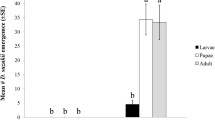Abstract
The maize-derived secondary chemical 6-methyoxybenzoxazoii-none (MBOA) and a tritiated derivative were prepared synthetically for a detailed examination of their toxicity and toxicokinetics in the European corn borer (ECB),Ostrinia nubilalis. During feeding trials with MBOA incorporated into meridic diets (at 0, 0.5, 1.5, 2.5, and 4.0 mg/g diet), the mean time to pupation and adult emergence was significantly lengthened at concentrations of 1.5 mg MBOA/g diet and above. Increased mortality occurred at concentrations at 1.5 mg/g and above. A decrease in the sex ratio (female/ total) and fecundity was observed at concentrations of 0.5 mg/g and above. The latter observations represent new biological effects related to MBOA. In tracer studies, both uptake and excretion of MBOA administered in diets to larvae increased linearly with concentration. Body burden values indicated that the ECB larvae were capable of excreting enough compound to maintain total tissue levels at approximately 50% of the dietary concentration. Total amount of label increased with larval stage, but decreased in adults due to a large amount of label eliminated in the pupal case. In topical application studies, elimination of the label in the frass was rapid, reaching 60% by 6 hr and 82% of applied dose by 24 hr. Accumulation of label in tissues other than hemolymph was small. The results show that MBOA is toxic to ECB, but the insect has efficient methods for minimizing these effects.
Similar content being viewed by others
References
Andona, V.H., Luza, J.G., Niemeyer, H.M., andCorcuera, L.J. 1980. Roleofhydroxamic acids in the resistance of cereals to aphids.Phytochemistry 19:1665–1668.
Argandona, V.H., Niemeyer, H.M., Corcuera, L.J. 1981. Effect of content and distribution of hydroxamic acids in wheat on infestation by the aphidScizaphis graminum.Phytochemistry 20:673–676.
ArgandoÑa, V.H., Corcuera, L.J., Niemeyer, H.M., andCampbell, B.C. 1983. Toxicity and feeding deterrency of hydroxamic acids from Gramineae in synthetic diets against the greenbugSchizaphis graminum.Entomol. Exp. Appl. 34:134–138.
Arnason, J.T., Philogene, B.J.R., Donskov, N., Hudon, M., Mcdougall, C., Fortier, G., Morand, P., Gardner, D., Lambert, J., andNozzolillo, C. 1985. Antifeedant and insecticidal properties of azadirachtin to the European com borer,Ostrinia nubilalis.Entomol. Exp. Appl. 38:29–34.
Berenbaum, M. 1980. Adaptive significance of midgut pH in larval Lepidoptera.Am. Nat. 115:138–146.
Bravo, H.R., andNiemeyer, H.M. 1986. A new product from the decomposition of 2,4-dihy-droxy-7-methoxy-1,4-benzoxazin-3-one (DIMBOA), a hydroxamic acid from cereals,Heterocycles 24:335–337.
Chio, L.L. 1976. A comparative pharmacodynamic study of six insecticides in eight insect species. PhD thesis, University of Illinois at Urbana-Champaign. University Microfilms International. Ann Arbor, Michigan.
Corcuera, L.J., Argandona, V.H., Pena, G.F., Ferez, F.J., andNiemeyer, H.M. 1982. Effect of a benzoxazin from wheat on aphids. Proc. 5th Int. Symp. Insect-Plant Relationship, Wageningen, 1982.
Corcuera, L.J., Queirolo, C.B., andArgandoÑa, V.H. 1985. Effects of 2-β-D-glucosyl-4-hydroxy-7-methoxy-1,4-benzoxazinn-3-one onScizaphis graminum (Rondani) (Insecta, Aphididae) feeding on artificial diets.Experentia 41:514–516.
Guthrie, W.D.,Russell, W.A., andJennings, C.W. 1972. Resistance of maize to second-brood European corn borers. Rep. 26th Ann. Corn and Sorghum Res. Conf. pp. 165–179.
Klun, J.A., andBrindley, T.A. 1966. Role of 6-methoxybenzoxazolinone in inbred resistance of host plant (maize) to first-brood larvae of European corn borer.J. Econ. Entomol. 59:711–718.
Klun, J.A., Tipton, C.L. andBrindley, T.A. 1967. 2,4-Dihydroxy-7-methoxy-1,4-benzoxazin-3-one (DIMBOA), an active agent in the resistance of maize to the European corn borer.J. Econ. Entomol. 60:1529–1533.
Klun, J.A., Tipton, C.L., Robinson, J.F., Ostren, D.L., andBeroza, M. 1970. Isolation and identification of 6,7-dimethoxy-2-benzoxazolinone from dried tissues ofZea mays (L.) and evidence of its cyclic hydroxamic acid precursor.J. Agric. Food Chem. 18:663–665.
Kubo, I., andKamikawa, T. 1983. Identification and efficient synthesis of 6-methoxy-2-benzox-azolinone (MBOA), an insect antifeedant.Experentia 39:355–358.
Leo, A., Mansch, C., andElkins, D. 1971. Partition coefficients and their uses.Chetn. Rev. 71:525–616.
Long, B.D., Dunn, G.M., andRoutley, D.G. 1975. Relationship of hydroxamic acid content in maize and resistance to northern corn leaf blight.Crop. Sci. 15:333–335.
Lynch, R.E. 1980. European corn borer: Yield losses in relation to hybrid and stage of corn development.J. Econ. Entomol. 73:159–164.
Nachman, J., Ronald, -. 1982. Convenient preparation of 2-benzoxazolinone with 1,1-carbon-yldiinidazole.J. Heterocycl. Chem. 19:1545–1547.
Olson, W.P., andO'Brien, R.D. 1963. The relation between physical properties and penetration of solutes into the cockroach cuticle.J. Insect Physiol. 9:777–786.
Ferez, F.J., andNiemeyer, H.M. 1986. Effect of borate on decomposition of 2-4-dihydroxy-7-methoxy-1-4-benzoxazin-3-one, a hydroxamic acid from Graminae.Heterocyde 24:13–16.
Reed, G.L., Brindley, T.A., andShowers, W.B. 1972. Influence of resistant corn leaf tissue on the biology of the European corn borer.Ann. Entomol. Soc. Am. 65:658–662.
Robinson, J.F., Klun, J.A., Guthrie, W.D., andBrindley, T.A. 1982. European corn borer (Lepidoptera: Pyralidae) leaf feeding resistance. DIMBOA bioassay.J. Kans. Entomol. Soc. 55:357–364.
Tang, C.S., Chang, S.H., Hoo, D., andYanagihara, K.H. 1975. Gas Chromatographie determination of 2(3)-benzoxazolinones from cereal plants.Phytochemistry 14:2077–2079.
Werstiuk, N.H., andTimmins, G. 1981. Hydrogen-deuterium exchange and rearrangement of polycyclic aromatic hydrocarbons in dilute acid-medium at elevated temperature.Can. J. Chem. 59:3218–3219.
Woodward, M.D., Corcuera, L.J., Helgenson, J.P., andUpper, C.D. 1978a. Decomposition of 2,4-dihydroxy-7-methoxy-2H-1,4-benzoxazin 3(4H)-one in aqueous solution.Plant Physiol. 61:796–802.
Woodward, M.D., Corcuera, L.J., Helgenson, J.P., Kelman, A., Upper, C.D. 1978b. Factors that influence the activity of 2,4-dihydroxy-7-methoxy-2H-1,4-benzoxazin-3(4H)-one onErwina species in growth assays.Plant Physiol. 61:803–805.
Author information
Authors and Affiliations
Rights and permissions
About this article
Cite this article
Campos, F., Atkinson, J., Arnason, J.T. et al. Toxicity and toxicokinetics of 6-methoxybenzoxazolinone (MBOA) in the european corn borer,Ostrinia nubilalis (Hübner). J Chem Ecol 14, 989–1002 (1988). https://doi.org/10.1007/BF01018788
Received:
Accepted:
Issue Date:
DOI: https://doi.org/10.1007/BF01018788




